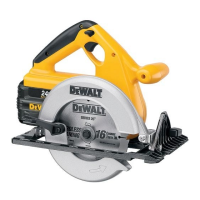19
5. USE OF DULL OR DIRTY BLADES
Dull blades cause increased loading of the saw. To compensate, an operator will
usually push harder which further loads the unit and promotes twisting of the blade
in the kerf. Worn blades may also have insufficient body clearance which increases
the chance of binding and increased loading.
6. LIFTING THE SAW WHEN MAKING BEVEL CUTS
Bevel cuts require special operator attention to proper cutting techniques –
especially guidance of the saw. Both blade angle to the shoe and greater blade
surface in the material increase the chance for binding and misalignment (twist) to
occur.
7. RESTARTING A CUT WITH THE BLADE TEETH JAMMED
AGAINST THE MATERIAL.
The saw should be brought up to full operating speed before starting a cut or
restarting a cut after the unit has been stopped with the blade in the kerf. Failure to
do so can cause stalling and kickback.
CUTTING
Support the work so that the cut will be on your right. Place the wider portion of the
saw shoe on that part of the work piece which is solidly supported, not on the
section that will fall off when the cut is made. As examples, Figure E14 illustrates the
CORRECT way to cut off the end of a board, and Figure E15 the WRONG way. Always
clamp work. Don’t try to hold short pieces by hand! Remember to support
cantilevered and overhanging material. Use caution when sawing material from
below.
Be sure saw is up to full speed before blade contacts material to be cut. Starting
saw with blade against material to be cut or pushed forward into kerf can result in
kickback.
Push the saw forward at a speed which allows the blade to cut without labouring.
Hardness and toughness can vary even in the same piece of material, and knotting
or damp sections can put a heavy load on the saw. When this happens, push the
saw more slowly, but hard enough to keep it working without much decrease in
speed.
Forcing the saw can cause rough cuts, inaccuracy, kickback and over-heating of the
motor.
Should your cut begin to go off the line, don’t try to force it back on. Release the
switch and allow blade to come to a complete stop. Then you can withdraw the saw,
sight anew, and start a new cut slightly inside the wrong one. In any event, withdraw
the saw if you must shift the cut. Forcing a correction inside the cut can stall the saw
and lead to kickback. IF SAW STALLS, RELEASE THE TRIGGER AND
BACK THE SAW UNTIL IT IS LOOSE. BE SURE BLADE IS STRAIGHT IN
THE CUT AND CLEAR OFF THE EDGE BEFORE RESTARTING.
As you finish a cut, release the trigger and allow the blade to stop before lifting the
saw from the work. As you lift the saw, the spring-tensioned telescoping guard will
automatically close under the blade. Remember the blade is exposed until this
occurs, never reach under the work for any reason whatsoever. When you have to
retract the telescoping guard manually (as is necessary for starting pocket cuts)
always use the retracting lever.
NOTE: When cutting thin strips, be careful to ensure that small cutoff pieces don’t
hang up on inside of lower guard.
When ripping (cutting with the grain) the use of a rip fence is recommended.
POCKET CUTTING
DISCONNECT TOOL FROM
BATTERY PACK WHEN MAKING
THIS OR ANY OTHER
ADJUSTMENT.
Adjust saw shoe so blade cuts at
desired depth. Tilt saw forward and rest
front of the shoe on material to be cut.
Using the retracting lever, retract blade
guard to an open position. Lower rear of
shoe until blade teeth almost touch
cutting line. Now release the blade
guard (its contact with the work will
keep it in position to open freely as you
start the cut) (Figure E16). Start the motor
and gradually lower the saw until its shoe rests flat on the material to be cut.
Advance saw along the cutting line until cut is completed. Release trigger and allow
blade to stop completely before withdrawing the blade from the material. When
starting each new cut, repeat as above. Never tie the blade guard in a raised
position.
E16

